Muskoka’s Aquatic Invaders
by Norman Yan
Olympic medals aren’t the only things that have recently come to Muskoka from the Socchi area. It’s also given us some of our most problematic invading species. Socchi is located in the Ponto-Caspian steppe, a huge area which includes parts of the Ukraine, Russia and Kazakhstan, and hosts three ancient seas – the Black, the Caspian and the Azov.
The Black Sea has a unique past; it’s been a freshwater lake at times, and at other times, including the present day, it’s a salty sea. As a result, its biota have a huge tolerance to variations in salinity, and therein lies a problem. The Black Sea is connected both to the global ocean through Istanbul, and to western European rivers and harbours via continuous river and canal systems. Thus, Black Sea life has made it to some European harbours, and ships exchanging ballast water in these harbours have picked up unwanted Ponto-Caspian stowaways and brought them to North America.
Several of the most problematic recent invaders of North American waters, including the round goby, zebra and quagga mussels, and the fishhook and spiny water fleas, have come to North America by this ballast water route. Zebra mussels have likely been introduced many times into Lake Muskoka (their larvae were caught in the lake as far back as 1989) but, as far as we know, they have failed to set up permanent residence, given the softness of Lake Muskoka waters; however, unlike the zebra mussel, the spiny water flea, Bythotrephes, has flourished in Muskoka’s waters.

Spiny water fleas on a fishing line.
The spiny water flea was detected in Lakes Muskoka, Rosseau and Joseph in 1989, in Fairy, Go Home, and Mary Lakes in 1990 and in Vernon and Peninsula Lakes in 1991. Since then, the invader has spread widely. By 2011, the spiny water flea had colonized at least 160 lakes in Ontario, and Muskoka, with 80 known invaded lakes, was ground zero for this regional spread.
Of course not all non-native species are damaging, in fact, most likely aren’t. However, it does appear that 10-20% of non-indigenous aquatic species are damaging, and the spiny water flea is one of those.
It is an open-water predator of plants and animals that are smaller than itself, and many native populations of water fleas have crashed since the invasion. The best studied case is Harp Lake east of Huntsville, where the diversity of a group of native zooplankton called Cladocera has fallen by 2-3 times in the summer, and the annual biodiversity of zooplankton has fallen by 20%.
Indeed, the spiny water flea appears to have offset some of the benefits of the reduced acidity of rain falling in Muskoka. In most Muskoka lakes, the biodiversity of native zooplankton has risen by about 15% over the last few decades because of a significant reduction in lake water acidity. This is great news, but in lakes invaded by the spiny water flea there has been no increase in this biodiversity.
We can reduce the spread of this invader. Research done at McGill University suggests it wasn’t river connections that spread the invaders among our lakes. Rather, it was the movement of people, and presumably their water-flea contaminated boats.
Research from the University of Minnesota has demonstrated that the spiny water flea and their resting eggs die after 6 hours of drying. So, please dry your boat and all your gear for 6 hours between lakes, and we can slow or perhaps even stop the continuing spread of this damaging invader among Muskoka lakes, 95% of which are not as yet invaded.
On September 12th, you can become a Researcher for a Day with the Muskoka Watershed Council and Sunset Cruises by joining me on a cruise of Lake Rosseau where you will make your own zooplankton net (materials provided) and learn about the living lawn mowers in our lakes while collecting and examining samples of both native and invasive zooplankton. Learn more at http://www.muskokawatershed.org/events/researcher-for-a-day/.
Past articles are available in this blog under the Watershed Notes Articles category or under Past Articles in the Resources section.
